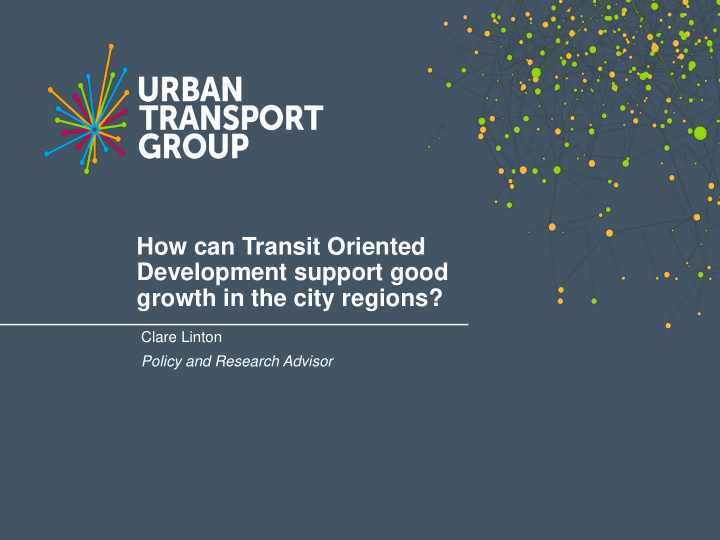



How can Transit Oriented Development support good growth in the city regions? Clare Linton Policy and Research Advisor
What is Transit Oriented Development? • C40 Cities describe Transit Oriented Development as: “ an urban planning principle that promotes high-density, mixed use development integrated with a robust public transport system” .
Seven key factors for successful Transit Oriented Development
Mobility hubs
The case for Transit Oriented Development Key policy areas that Transit Oriented Development can support include: • Agglomeration economies • Housing • Air quality and carbon emissions • Congestion • Social inclusion, employment and skills • Public health • Public transport patronage
Kirkstall Forge, West Yorkshire • Kirkstall Forge is a development in Leeds, transforming a brownfield site adjacent to an existing railway line • A new station has been opened at the site, which connects the site with Leeds (a 6 minute journey) and Bradford (15 minutes) • On completion, the development will provide 1,050 new homes, 300,000 square feet of office space and 100,000 square feet of retail, leisure and community facilities, including a school
King’s Cross, London • The development of land around King’s Cross station in London represents a flagship scheme in the UK, transforming a 67 acre unused industrial site into a vibrant mixed-use development • It is anticipated that on completion of the scheme in 2020 there will be 2,000 homes, 3.4 million square feet of office space and 50,000 square feet of retail and leisure space • 40% of the development is open space, creating a network of streets and footpaths through parks, gardens and squares
Northstowe, Cambridgeshire • A new town being developed in Cambridgeshire on a former RAF base which will provide 10,000 new homes on completion • Served by the Cambridgeshire Guided Busway • 10 minutes from the new Cambridge North railway station • Developers at Northstowe are promoting public transport, walking and cycling to new residents, offering subsidised bus taster tickets, walking and cycling equipment vouchers up to £50 and cycle taster sessions
Vauban, Freiburg, Germany • Vauban is a new development 3km from the centre of Freiburg, with 2,000 homes built on a brownfield site. • The area is served by a tram, which operates a peak service every five minutes and all households are within 400m of a tram stop. • The area prioritises walking and cycling, with low speed limits and ‘home zone’ rules meaning cars should give way to pedestrians. • 40% of households do not own a car and 57% of residents of non-car owning households gave up the car when they moved to Vauban.
Bay Area Rapid Transit (BART) California, USA • BART have a number of targets for expanding Transit Oriented Development including by 2040: ▪ 20,000 new residential units on BART property; ▪ 84% increase in housing units within half a mile of BART stations, which equates to 155,800 new units; ▪ 53% increase in jobs within half a mile of BART stations (277,500 new jobs); and ▪ To reduce the number of station areas (surrounding half a mile) that are more than one mile from a grocery store down to zero, from a 2010 baseline of nine
How can we deliver more Transit Oriented Development? • A national planning framework that favours Transit Oriented Development. • A national funding framework with more options for ensuring that value uplift from new developments can be used to improve transport connectivity. • More influence over land held by agencies of national Government which would be prime sites for Transit Oriented Developments. • More devolution of powers over stations where a city region transport authority has the ambition and capacity to take on those responsibilities. • Measures to improve the planning capacity of local authorities in order to respond effectively, rapidly and imaginatively to opportunities for Transit Oriented Development.
Recommend
More recommend